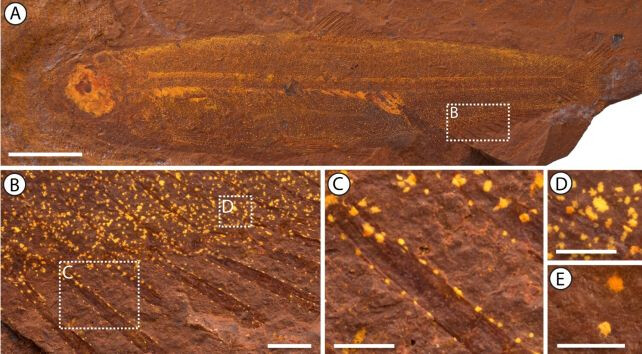
McGraths Flat, Australia – A remarkable discovery at McGraths Flat, an extraordinary fossil bed nestled in the arid grasslands of Australia, has yielded a new species of fish that lived 15 million years ago during the Miocene epoch. The exceptionally preserved fossils, named Ferruaspis brocksi, have allowed paleontologists to peer into the ancient past with unprecedented clarity, revealing details about the fish's coloration, diet, and even parasites.
Led by Matthew McCurry of the Australian Museum Research Institute, the team's findings have astonished the scientific community. The fossils, discovered by Jochen Brocks of the Australian National University, were found in a Lagerstätte, a site known for its exquisite preservation of soft tissue and fine details within iron-rich goethite rocks.
"This little fish is one of the most beautiful fossils I've found at McGraths Flat," Brocks said. "This discovery opens new avenues for understanding the evolutionary history of Australia's freshwater fish species and ancient ecosystems."
The level of preservation at McGraths Flat is exceptional, allowing researchers to discern structures smaller than a cell. In the case of Ferruaspis brocksi, the team was able to analyze the fish's stomach contents, revealing a diet primarily consisting of invertebrates, including insect wings and bivalve shells. Most notably, the fish consumed large quantities of midge larvae, tiny aquatic insects.
"The discovery of the 15 million-year-old freshwater fish fossil offers us an unprecedented opportunity to understand Australia's ancient ecosystems and the evolution of its fish species," McCurry explained.
One particularly intriguing find was a juvenile freshwater mussel, known as a glochidium, attached to the fish's tail. These mussels typically use fish as hosts, hitching rides to travel along streams.
Furthermore, the researchers were able to identify melanosomes, pigment-carrying structures in the fish's skin, revealing its coloration. The fish had a darker dorsal side and a paler ventral side, with two dark stripes running along its body.
"Fossilized melanosomes have previously enabled paleontologists to reconstruct the color of feathers," said Michael Frese of the University of Canberra and CSIRO, "but melanosomes have never been used to reconstruct the color pattern of a long extinct fish species."
The McGraths Flat site continues to yield remarkable discoveries. Beyond Ferruaspis brocksi, paleontologists have uncovered a "giant" trapdoor spider, as well as numerous plant, insect, and bird fossils. These findings paint a vivid picture of a once temperate, wet rainforest teeming with life.
"The fossils found at this site formed between 11 and 16 million years ago and provide a window into the past," McCurry concluded. "They prove that the area was once a temperate, wet rainforest and that life was rich and abundant in the Central Tablelands."
The ongoing research at McGraths Flat promises to reveal further insights into Australia's ancient ecosystems, offering a glimpse into a world long gone but remarkably preserved.
[Copyright (c) Global Economic Times. All Rights Reserved.]






























